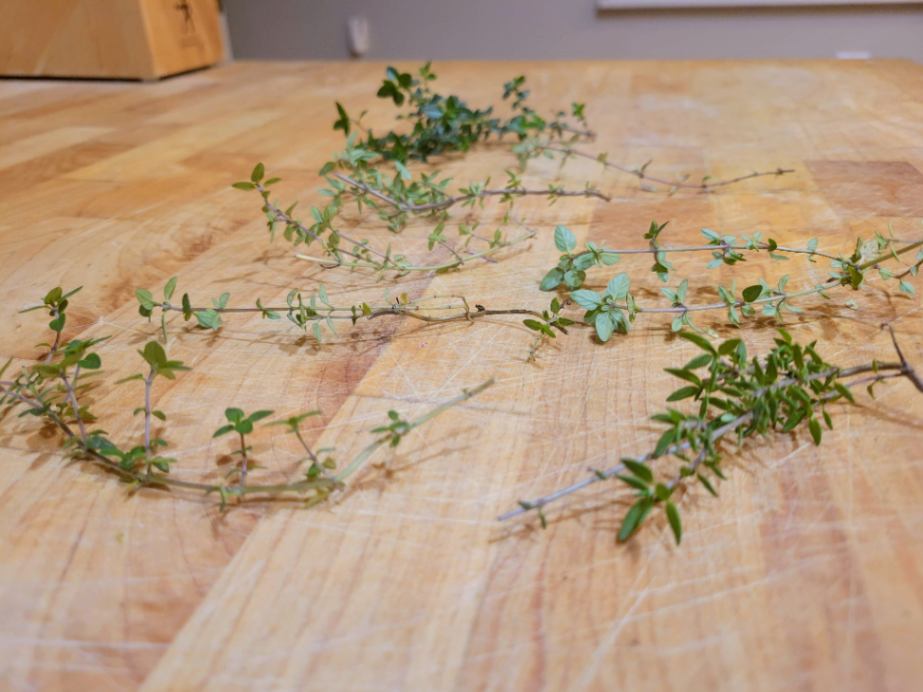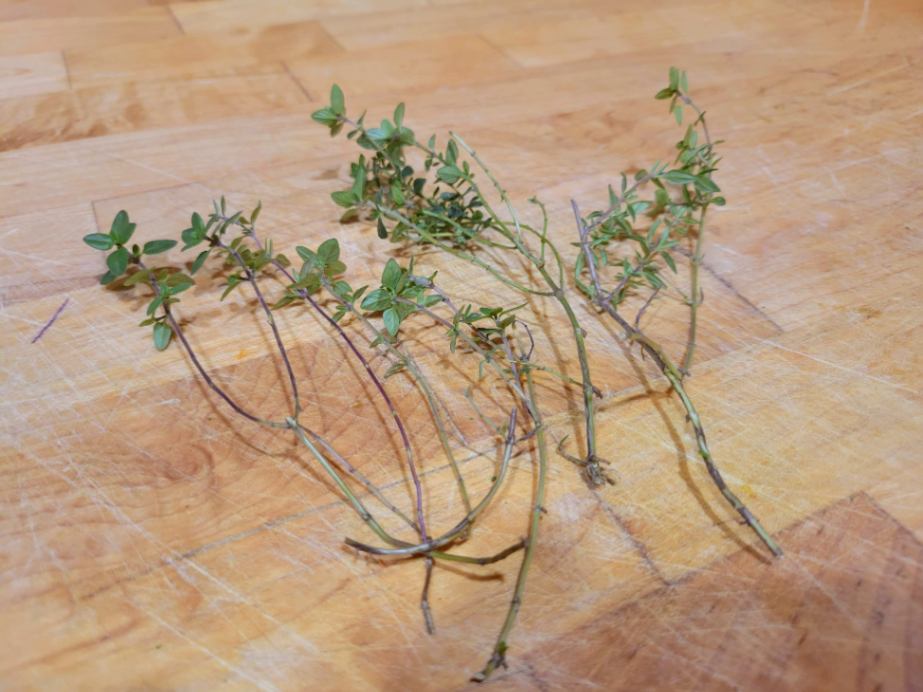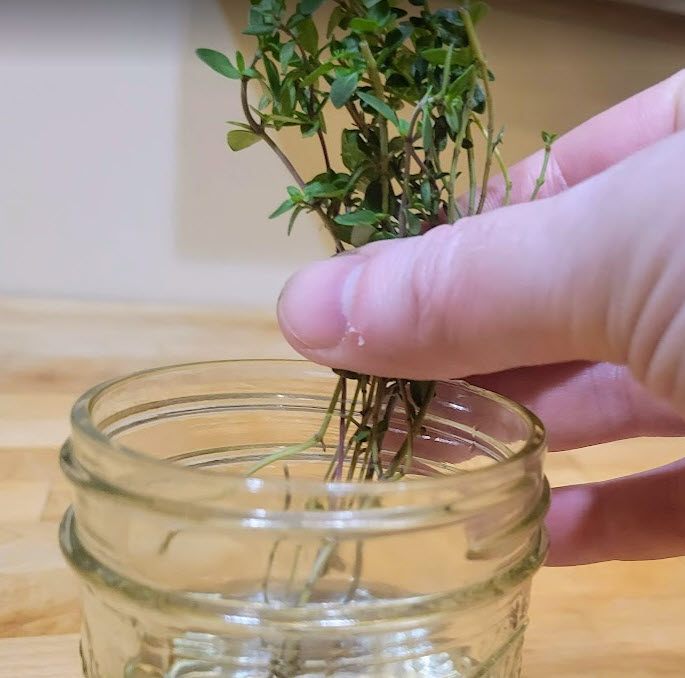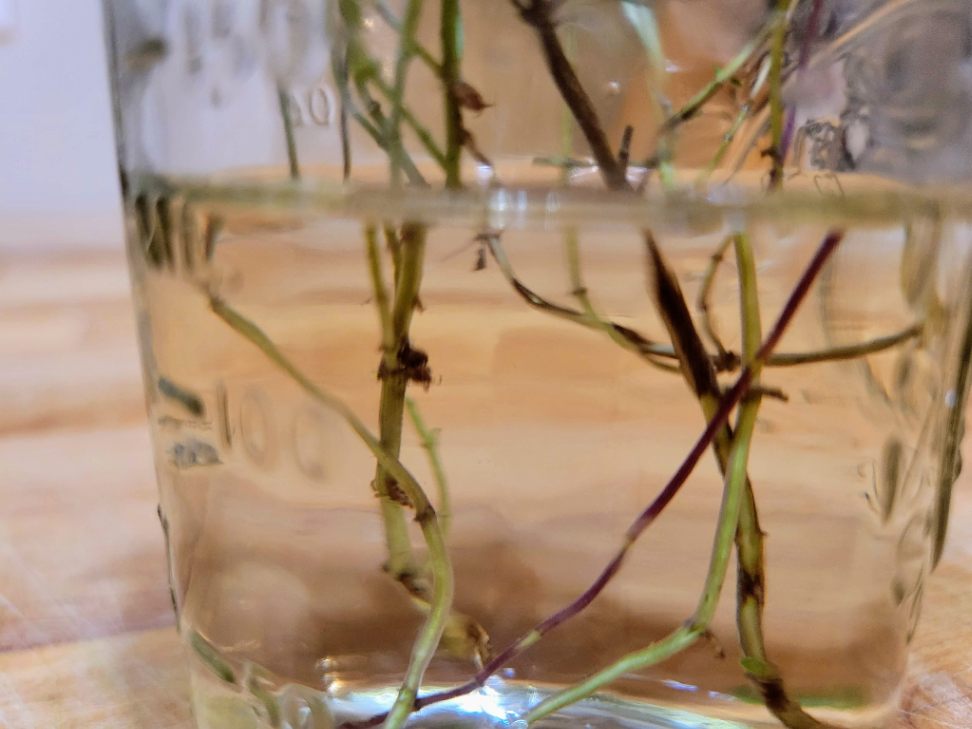This post may contain affiliate links which means I may receive a commission for purchases made through links. I only recommend products that I have personally used. As an Amazon Associate I earn from qualifying purchases. Learn more on my Private Policy page.
Growing thyme from cuttings is a simple way to propagate this aromatic herb, allowing you to easily expand your herb garden.
To grow thyme from cuttings in water, select healthy 3-6 inch branches, strip off the lower leaves, and place them in water in a clean container, submerging the bare stems. Place the container in indirect light, change the water regularly, and transplant the stems into pots once the roots reach 1-2 inches.
Keep reading to learn the best techniques and tips for how to grow thyme from cuttings in water at home.
Table of Contents
Preparing Your Thyme Cuttings
Selecting Healthy Thyme Branches for Cuttings
To successfully grow thyme from cuttings in water, starting with healthy branches is crucial. Select thyme branches free from diseases or pests with vibrant green leaves, avoiding any branches that appear wilted or damaged.

Taking multiple cuttings from the mother plant is important, as not all cuttings will successfully root. The more sprigs you harvest, the more you increase your chance of success in rooting your cuttings.
The Ideal Length and Type of Cutting
Aim for thyme cuttings that are 3-6 inches (8-15 cm) in length. This size is ideal because it provides enough stem length for rooting while still being manageable. Make sure you choose semi-hardwood cuttings from the mother plant. In my experience, semi-hardwood cuttings root better than softwood cuttings, as the stems are not too soft like new growth but not too woody either.
Strip Leaves from the Lower Part of the Cuttings
Before placing your thyme cuttings in water, remove the leaves from the lower part of the stem, keeping only the top 25-30% of the leaves. Rooting bare stems helps prevent rotting and directs more energy toward root formation rather than sustaining foliage.

Once you have selected healthy branches and prepared them by making clean cuts and removing lower leaves, you can begin rooting your thyme cuttings in water.

Rooting Thyme Cuttings in Water
The Importance of Using Clean Containers
To successfully grow thyme from cuttings in water, starting with clean containers is critical. Dirty containers can introduce harmful bacteria or fungi that may inhibit root development. Ensure your containers are thoroughly cleaned and sanitized before use. Also, use fresh, clean water to provide the ideal environment for root growth.

Submerge the Nodes but Not the Leaves
When placing thyme cuttings in water, submerge the nodes on the stems, but avoid having any leaves come into contact with water. Nodes are the points on the stem where new roots will emerge. Submerging these nodes in water creates an optimal condition for root development. However, ensure that no leaves come into direct contact with the water, as this can lead to rotting or fungal issues.

While some gardeners utilize growth hormone to encourage root growth, I’ve found that it’s not completely necessary. Rooting hormone contains auxins, which are plant hormones that promote root formation.
While using growth hormone can increase the odds that any individual thyme branch will root, I don’t think it’s necessarily worth the extra expense as long as you try to root enough stems.
Placement and Light Requirements During the Rooting Phase
Proper placement and light requirements play a significant role during the rooting phase of thyme cuttings in water. Place your containers in a location that receives lots of light but not direct sunlight. Direct sunlight can be too intense and may cause excessive drying or scorching of the cuttings. By providing adequate light without direct exposure, you encourage healthy growth and prevent any potential damage.

Water Changing Schedule to Prevent Rotting
Establish a regular schedule for changing the water to prevent rotting and maintain a healthy growing environment for your thyme cuttings. Stagnant water can become a breeding ground for bacteria and fungi, hindering root development or even causing decay.
Using fresh water promotes oxygenation and prevents any build-up of harmful microorganisms. Aim to change the water every few days or whenever it begins to appear cloudy or murky.
Following these guidelines when rooting thyme cuttings in water increases your chances of successful propagation. Remember to use clean containers and fresh water to create an optimal environment for root development. Submerge the nodes while avoiding submerging leaves to prevent rotting or fungal issues. Place your containers in a location with bright, indirect sunlight and establish a regular water-changing schedule to maintain a healthy growing environment.
Monitoring Root Growth
After successfully taking thyme cuttings and placing them in water, it’s essential to monitor the progress of root growth.
Check Regularly for Signs of Root Development
Within a few weeks of placing the thyme cuttings in water, you should start seeing signs of new roots forming. Keep a close eye on the bottom ends of the stems submerged in water. Look for small white bumps or protrusions emerging from the nodes or leaf axils.
You should see tiny white bumps indicating roots are beginning to grow from the stem. As time goes by, these roots will continue to lengthen and strengthen, providing a solid foundation for your thyme plant.
As the roots develop further, they will become more visible and pronounced. You should notice thin, thread-like structures growing from the bottom ends of the stems. These roots will gradually increase in number and thickness as they mature.
The Desired Length of Roots Before Potting
It’s important to make sure your thyme cuttings’ root systems have reached an adequate length before transplanting them into pots or directly into the ground. Aim for roots that are at least 1-2 inches long before proceeding with potting.
Allowing enough time for robust root growth before transplanting increases your chances of successful establishment and minimizes any potential transplant shock. Thyme plants with well-developed roots are better equipped to absorb nutrients and water from the soil, ensuring their overall health and vitality.
Potting Rooted Thyme Cuttings
Once the roots on your thyme cuttings are 1-2” (2.5-5 cm), it’s time to transfer them into pots with well-draining soil.
Gently Remove Each Cutting from Water
Carefully remove each cutting from the water in which they were rooting. Be gentle to avoid damaging the delicate roots that have formed. It’s essential to handle them with care as they are still fragile at this stage.
Plant Carefully in Its Own Pot
Take each cutting and plant it carefully in its own individual pot. Make sure to choose pots that provide adequate drainage, as this will prevent waterlogging and root rot. Fill each pot with well-draining soil, such as a mixture of potting soil and perlite, sand, or cactus mix.
Provide Adequate Moisture
Thyme plants require moisture to thrive but are susceptible to root rot if overwatered. Water your newly potted thyme cuttings thoroughly, allowing excess water to drain out through the bottom of the pots. Afterward, ensure not to let the soil completely dry between watering sessions.
Provide Sufficient Light to Your Thyme
To encourage growth and ensure healthy development, place your potted thyme cuttings in an area that receives 6-8 hours of sunlight daily. If growing indoors, you may also choose to use grow lights.
Monitor Growth and Adjust Care Accordingly
Keep a close eye on your potted thyme cuttings as they grow. Look out for signs of wilting or discoloration, which may indicate watering or light exposure issues. Adjust their care accordingly by increasing or decreasing watering frequency or adjusting their position relative to light sources.
Growing thyme from cuttings in water and then potting them is an effective method for propagation. It allows you to expand your thyme collection or replace older plants without needing to purchase new ones. By following these steps and providing the right conditions, you can successfully transition your rooted thyme cuttings into individual pots and continue their growth journey.
For more tips and techniques on growing thyme, check out my article on Planting Thyme: Essential Steps for a Successful Start.

Frequently Asked Questions (FAQs)
Can I grow thyme from seeds instead of cuttings?
While growing thyme from cuttings is a popular method due to its high success rate, you can also grow thyme from seeds. Keep in mind that starting from seeds may take longer for the plants to reach maturity compared to using cuttings.
How often should I fertilize my potted thyme plants?
Thyme doesn’t require heavy feeding, so fertilizing once or twice during the growing season should be sufficient. Use a balanced organic fertilizer and follow the instructions on the packaging for application rates.
Can I propagate thyme using division?
Dividing an established clump of thyme is another effective way to propagate the herb. Dig up the clump and carefully separate it into smaller sections, each with its own roots and foliage. Replant the divisions in pots or directly in your garden.
Can I grow thyme indoors?
Thyme can thrive indoors as long as it receives sufficient sunlight and is planted in well-draining soil. Place your potted thyme near a sunny window or use artificial grow lights to provide the necessary light requirements.
How often should I prune my thyme plants?
Pruning thyme regularly helps maintain its shape, encourages bushier growth, and prevents it from becoming leggy. You can trim back the stems by about one-third every spring or whenever you notice excessive growth.
What herbs can I start from cuttings?
Woody herbs like rosemary, thyme, lavender, sage, and oregano are relatively easy to propagate from cuttings. It’s best to take semi-hardwood cuttings from these herbs versus taking cuttings from fresh growth.
See my article on How to Grow Rosemary from Cuttings for more information.
Last Updated on 9 November 2023 by Bob Lee

